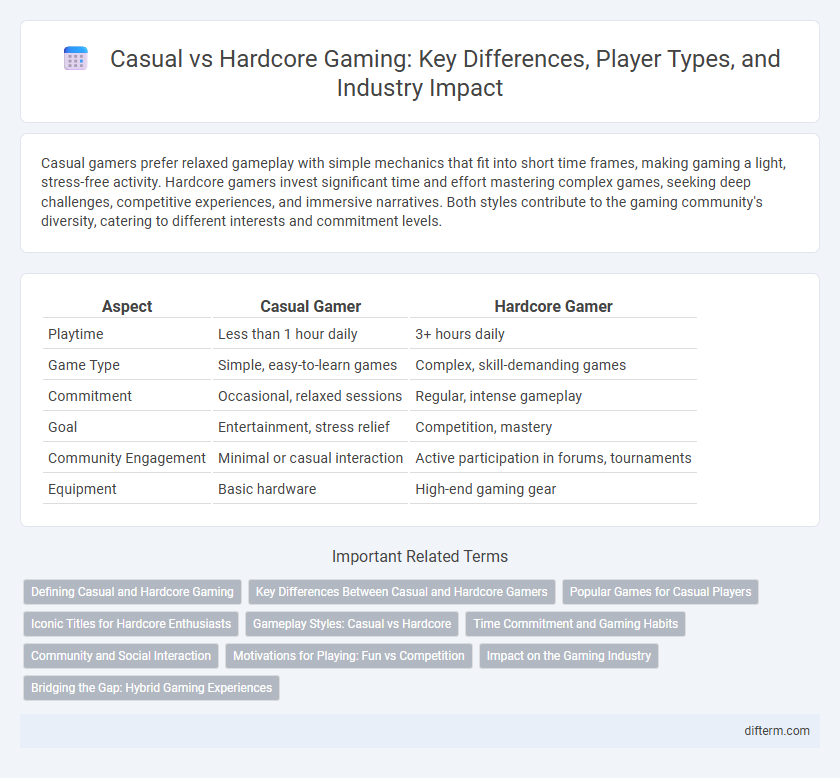Casual gamers prefer relaxed gameplay with simple mechanics that fit into short time frames, making gaming a light, stress-free activity. Hardcore gamers invest significant time and effort mastering complex games, seeking deep challenges, competitive experiences, and immersive narratives. Both styles contribute to the gaming community's diversity, catering to different interests and commitment levels.
Table of Comparison
| Aspect | Casual Gamer | Hardcore Gamer |
|---|---|---|
| Playtime | Less than 1 hour daily | 3+ hours daily |
| Game Type | Simple, easy-to-learn games | Complex, skill-demanding games |
| Commitment | Occasional, relaxed sessions | Regular, intense gameplay |
| Goal | Entertainment, stress relief | Competition, mastery |
| Community Engagement | Minimal or casual interaction | Active participation in forums, tournaments |
| Equipment | Basic hardware | High-end gaming gear |
Defining Casual and Hardcore Gaming
Casual gaming involves simple mechanics, shorter play sessions, and accessible content designed for relaxation and entertainment without intense commitment. Hardcore gaming requires advanced skills, longer playtimes, competitive challenges, and immersive experiences, often involving complex strategy, high-level coordination, and persistent progression. Key factors defining these categories include time investment, game complexity, player motivation, and social interaction intensity.
Key Differences Between Casual and Hardcore Gamers
Casual gamers typically engage in gaming for relaxation and short-term enjoyment, often playing mobile or social games with simple mechanics. Hardcore gamers invest significant time and resources, seeking complex challenges and competitive experiences in genres like MMOs, FPS, and strategy games. Key differences include dedication level, skill acquisition, preferred game complexity, and the importance of community and achievements.
Popular Games for Casual Players
Popular games for casual players often emphasize easy-to-learn mechanics and short play sessions, making titles like Animal Crossing: New Horizons, Among Us, and Stardew Valley highly attractive. These games prioritize accessibility and social interaction, allowing players to enjoy immersive experiences without intense time commitments or complex strategies. Mobile games such as Candy Crush Saga and Clash Royale also dominate casual gaming, offering quick entertainment suitable for players with varied schedules.
Iconic Titles for Hardcore Enthusiasts
Iconic titles for hardcore gaming enthusiasts include franchises like Dark Souls, which challenge players with punishing difficulty and intricate lore, and competitive esports staples such as Counter-Strike: Global Offensive that demand precision and strategic skill. Games like The Witcher 3 offer expansive worlds and deep role-playing mechanics, appealing to those committed to immersive experiences. These titles define hardcore gaming by pushing player mastery and dedication beyond casual play.
Gameplay Styles: Casual vs Hardcore
Gameplay styles in gaming range from casual to hardcore, with casual players favoring relaxed, accessible experiences that emphasize fun and social interaction. Hardcore gamers prioritize challenging mechanics, competitive elements, and immersive narratives, often dedicating significant time and effort to mastering complex systems. Understanding these contrasting gameplay preferences helps developers tailor content, balancing accessibility with depth to engage diverse player demographics.
Time Commitment and Gaming Habits
Casual gamers typically engage in short, flexible play sessions with moderate time commitment, often balancing gaming alongside other daily activities. Hardcore gamers invest extensive hours consistently, showing dedication through frequent, prolonged gaming sessions and competitive play. Their gaming habits reflect a higher focus on skill development and immersion within complex game mechanics or online communities.
Community and Social Interaction
Casual gamers often engage in social interactions through accessible, community-driven platforms like mobile games and social networks, fostering relaxed and inclusive environments. Hardcore gamers participate in competitive multiplayer arenas and specialized forums, where social bonds are built around shared skills and strategic collaboration. Both communities thrive on interaction but differ in intensity and commitment, shaping unique social dynamics within the gaming ecosystem.
Motivations for Playing: Fun vs Competition
Casual gamers primarily seek entertainment and relaxation, valuing fun and social interaction over skill mastery or winning. Hardcore gamers are driven by competition, striving for achievement, high scores, and mastering game mechanics to outperform others. These contrasting motivations shape different gaming habits and community engagements within the gaming culture.
Impact on the Gaming Industry
Casual gaming has expanded the market by attracting a broader audience, driving revenue through accessible mobile and social games integrated with microtransactions and ad-based monetization. Hardcore gaming maintains a dedicated player base invested in complex narratives, competitive esports, and immersive experiences, promoting technological advancements in graphics, AI, and hardware performance. The coexistence of casual and hardcore segments fuels innovation, diversifies content, and sustains the industry's economic growth by targeting varying player engagement levels.
Bridging the Gap: Hybrid Gaming Experiences
Hybrid gaming experiences blend casual and hardcore elements to create engaging gameplay that appeals to diverse player types. By integrating accessible mechanics with deeper strategic challenges, developers bridge the gap between casual and hardcore gamers, fostering inclusive communities. Titles like "Fortnite" and "Minecraft" exemplify this approach, combining simple entry points with competitive or creative depth.
casual vs hardcore Infographic

 difterm.com
difterm.com